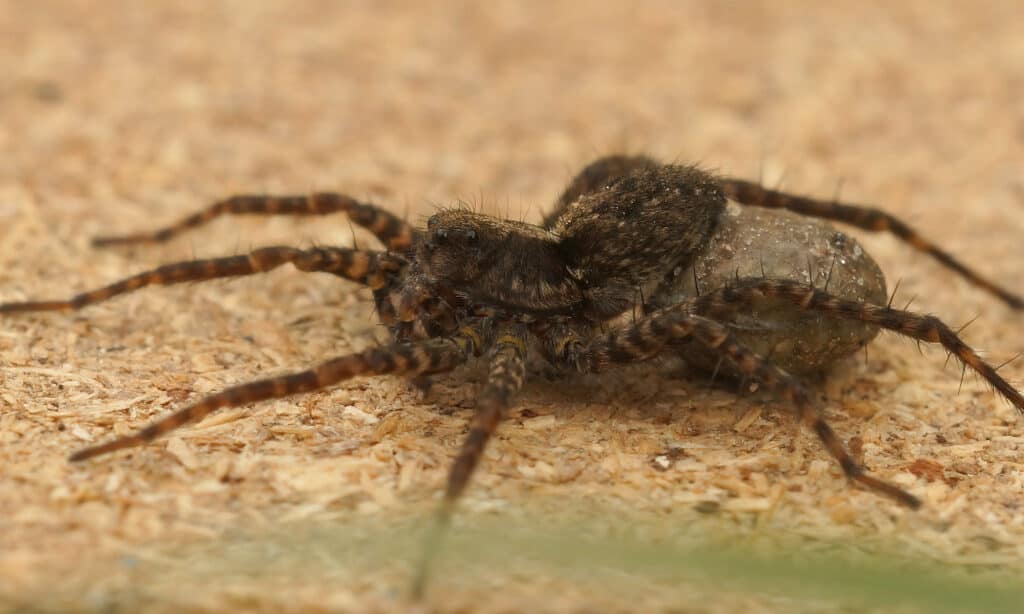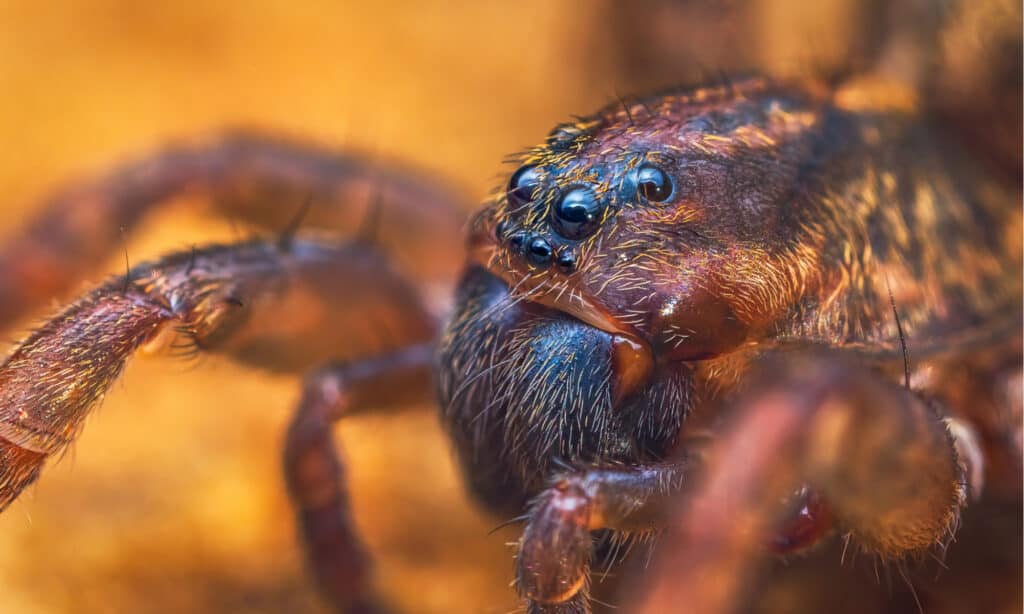Tennessee is famous for its music scene, high-quality whiskey, great-tasting food, and natural beauty. But did you know beyond the breathtaking beauty lies the hairy wolf spiders? Yes, these arachnids are common in the state!
Unlike other spiders, most wolf spiders don’t spin webs but prefer chasing the prey or ambushing it. Their eight eyes arranged in three rows provide excellent eyesight. Thanks to their color patterns, wolf spiders have the great advantage of camouflaging when looking for prey, which makes them agile hunters!
Read on to learn more about where wolf spiders live in Tennessee, how to identify them, and what they eat.
What Is a Wolf Spider?

Wolf spiders belong to the
Lycosidaefamily.
©HWall/Shutterstock.com
Wolf spiders belong to the Lycosidae family. There are over 2,800 known wolf species grouped into 124 genera. Some of the most common wolf spider species in Tennessee include:
- Tigrosa aspersa
- Tigrosa georgicola
- Trochosa sepulchralis
- Tigrosa annexa
1. Tigrosa aspersa
Tigrosa aspersa is a large wolf spider commonly found in Tennessee. Tigrosa spiders are very similar in characteristics to the other wolf spiders. They are robust and agile hunters who do not construct a web to catch prey but prefer chasing it over short distances. T. aspersa spiders are slightly larger than their close relatives, Tigrosa helluo.
2. Tigrosa georgicola
Tigrosa georgicola is a wolf spider species native to the southeastern United States. It’s one of the most common spiders in Tennessee found in woodlands, particularly in leaf litter or under logs. They have dark brown bodies with a light brown stripe running through the center of the cephalothorax. They are typically small in size, with females measuring approximately 0.6 – 0.8 inches (16-22 mm) long, while males are 0.4 – 0.6 inches (10-17 mm) long.
3. Trochosa sepulchralis
Trochosa sepulchralis is another member of the Lycosidae family found in Tennessee. These spiders are commonly referred to as black widow spiders due to their nearly uniform black abdomens. They also have reddish-brown legs covered with coarse bristles. They live mostly under logs and in rocks and sometimes close to ponds or streams.
4. Tigrosa annexa
Tigrosa annexa is another wolf spider species often spotted in Tennessee. These spiders come in three color variations – brown, black, and tan. They have a unique long carapace and thick, strong legs. Unlike most wolf spiders, Tigrosa annexa spiders are primarily seen in urban areas.
How To Identify Wolf Spiders in Tennessee

Wolf spiders have large and powerful front appendages, which are useful when hunting and dragging prey.
©Lukas Jonaitis/Shutterstock.com
Wolf spiders in Tennessee bear striking similarities with other wolf spiders across the globe. As already mentioned, they have eight eyes; two medium-sized eyes on the upper row, four small eyes on the bottom row, and two large eyes on the middle row.
They also have hairy brown bodies with various color patterns on their backs. They range in size from 0.24 to 1.2 inches. Females are slightly bigger than males. These wolf spiders also have large and powerful front appendages, which are useful when hunting and dragging prey.
Are Wolf Spiders in Tennessee Venomous?
Wolf spiders found in Tennessee are venomous, but studies have shown that they do not attack humans unless they feel cornered or provoked. Most species have venom that paralyzes prey. The venom, however, cannot cause serious issues to humans apart from mild pain, itching, and swelling.
Where Can You Find Wolf Spiders in Tennessee?
Since they mostly feed on small insects, wolf spiders in Tennessee live in open fields, with research suggesting that they prefer flatter and more open areas. They can also inhabit areas around rural and urban homes, where they can eat cockroaches and other home pests.
Most wolf spiders live in burrows and either make their burrows or inhabit abandoned ones.
What Do Wolf Spiders Eat in Tennessee?

Wolf spiders primarily eat small insects, such as grasshoppers, crickets, cockroaches, and flies.
©Vida Shams/Shutterstock.com
Tennessee wolf spiders are very good hunters, and just like other wolf spider species, they hunt in a way similar to wolves. Their diet consists primarily of small insects, such as grasshoppers, crickets, cockroaches, flies, and more. They are predominantly insectivores.
Over the years, they have developed a variety of hunting tactics. Some rely on their speed and powerful legs to overcome their prey.
On the other hand, other wolf spiders prefer stealthy hunting techniques, which involve waiting in burrows for prey to wander around. They also rely on their camouflage to get close enough to the prey without being detected.
Wolf Spider Predators in Tennessee
Though excellent hunters, wolf spiders may become prey to larger predators, including lizards, amphibians, wasps, and spider-eating birds. Tennessee wolf spiders are also a food source for large arthropods, including scorpions.
Reproduction and Life Cycle of Wolf Spiders
Female wolf spiders are unique in how they carry their young. Their egg sac is attached to the abdomen. They keep holding their abdomens raised to avoid dragging the egg case on the ground. Some females occasionally stay in the sun to keep the eggs warm.
After the incubation period, young wolf spiders are hatched and attain sexual maturity in a few weeks. Wolf spiders are not social; research has shown that the offspring may only stay and socialize with the mother after birth. This will help them develop better hunting skills.
Like all wolf spiders, those in Tennessee have an average lifespan of 1 – 2 years. Contrary to their portrayal, wolf spiders are not as scary and intimidating. In fact, they can even be kept as pets!
Up Next:
- 10 Spiders in Tennessee
- 5 of the Biggest Spiders in Tennessee
- Arizona Wolf Spiders: Everything You Need to Know
- Wolf Spiders in California: Everything You Need to Know
The photo featured at the top of this post is © Marshal Hedin / Creative Commons – License / Original
Sources
- World Wide Science, Available here: https://worldwidescience.org/topicpages/b/burrowing+wolf+spiders.html
- The University of Chicago Press, Available here: https://www.journals.uchicago.edu/doi/full/10.1086/698302
- Springer Link, Available here: https://link.springer.com/chapter/10.1007/978-3-642-71552-5_4
Thank you for reading! Have some feedback for us? Contact the AZ Animals editorial team.







